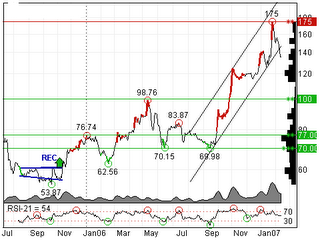WORLD-MATRIX-STRENGTHS-OF-STOCK-MARKETS
The markets are at a juncture that it has become difficult to judge the markets’ course while it is not all that difficult to judge the strength of individual scrip. We have to assess the markets in terms of some macro level study. This time I am giving an idea about the strengths of different world stock markets as represented by their leading indices. This would be done by evaluating the going P/E ratio by adjusting it suitably against the prevalent inflation level and the real rate of interest in the respective economy. I am going to take the real interest rate as 3% which has been seen to be the real rate in most economies with the 10 year gilt yield as the bench mark. The following table gives the idea of the Relative Strength(R/S) or say denotes the level of exuberance or melancholy in different stock markets around the world (Please see the 1000 mark as the balanced position without bias).
COUNTRY-INDEX- VALUE-P/E-INFLATION.
BRAZIL-BOVESPA- 43018-12.46 -4.1.
CHINA -SHANGHAI-2218-33.41 -2.20.
HK - HENGSENG-18907-14.65 -2.50.
INDIA- SENSEX -13000-23.00 -6.00.**
JAPAN- NIKKI -16640-39.60 -0.70.
MALAYSIA-KLSE -1088 -19.04 -2.70.
MEXICO- BOLSA -25830-14.60 -2.70.
SOUTH K-KOSPI -1376 -11.86 -1.70.
USA -DOW-JONS-12315-22.95 -2.90.
UK -FYSE100- 6156 -17.60 -2.40
You will notice from the above that while the variation in P/E ratio ranges from 10.91 for Thailand to 39.60 for Japan. There is however lesser variation in terms of relative strengths i.e. from 794 points for South Korea to 1970 points for Indonesia. Now we see the P/E ratios in a different light and find that the P/E for Indonesia is way up while for South Korea is way down. Either two are wrong or there would be some unknown facts/special matters regarding these two countries to come out in open. Indian and Chinese markets are also on the high side along with USA when seen from the angle of relative discounting of P/Es. These three economies are rated as the most important too and rightfully so and are therefore getting the substantial discounting. Seen against other economies it seems that the optimism here in India, in China and also in the United States is too highly pitched and therefore it may be said that the corrections would be fast and the room for decline is much in all these three cases. When you see the extraordinary trading pattern here in India, you must also be alarmed that this drama may not have much to deliver in practical terms. The value of Factor has been arrived by dividing 100 by the sum of rate of inflation and normal real rate of interest of 3%. I am not saying that this should be taken as the only and ultimate truth but what has come out is definitely of value and lets us make better sense of the P/E ratio for the indices in different economies with differing strengths and GDP growth possibilities.
COUNTRY-INDEX- VALUE-P/E-INFLATION.
BRAZIL-BOVESPA- 43018-12.46 -4.1.
CHINA -SHANGHAI-2218-33.41 -2.20.
HK - HENGSENG-18907-14.65 -2.50.
INDIA- SENSEX -13000-23.00 -6.00.**
JAPAN- NIKKI -16640-39.60 -0.70.
MALAYSIA-KLSE -1088 -19.04 -2.70.
MEXICO- BOLSA -25830-14.60 -2.70.
SOUTH K-KOSPI -1376 -11.86 -1.70.
USA -DOW-JONS-12315-22.95 -2.90.
UK -FYSE100- 6156 -17.60 -2.40
You will notice from the above that while the variation in P/E ratio ranges from 10.91 for Thailand to 39.60 for Japan. There is however lesser variation in terms of relative strengths i.e. from 794 points for South Korea to 1970 points for Indonesia. Now we see the P/E ratios in a different light and find that the P/E for Indonesia is way up while for South Korea is way down. Either two are wrong or there would be some unknown facts/special matters regarding these two countries to come out in open. Indian and Chinese markets are also on the high side along with USA when seen from the angle of relative discounting of P/Es. These three economies are rated as the most important too and rightfully so and are therefore getting the substantial discounting. Seen against other economies it seems that the optimism here in India, in China and also in the United States is too highly pitched and therefore it may be said that the corrections would be fast and the room for decline is much in all these three cases. When you see the extraordinary trading pattern here in India, you must also be alarmed that this drama may not have much to deliver in practical terms. The value of Factor has been arrived by dividing 100 by the sum of rate of inflation and normal real rate of interest of 3%. I am not saying that this should be taken as the only and ultimate truth but what has come out is definitely of value and lets us make better sense of the P/E ratio for the indices in different economies with differing strengths and GDP growth possibilities.




